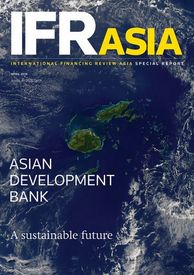Paying it forward
After winning support for his vision for the next decade last year, ADB President Takehiko Nakao is building consensus around changes to loan pricing and concessional funding.

Sustainability is a key concern for Fiji, the host of this year’s Asian Development Bank annual meetings. Its low-lying outer islands are under threat from rising sea levels as a result of climate change, and ocean plastics and overfishing are a growing risk to its revenues. The ADB also needs to work hard to ensure its sustainability. To keep shareholders on side, it is reforming its lending practices to prioritise poorer countries and address social issues, such as gender equality and education. The bank is also expanding into more commercial...Read more
To purchase printed copies or a PDF of this report, please email leonie.welss@lseg.com and shahid.hamid@lseg.com
After winning support for his vision for the next decade last year, ADB President Takehiko Nakao is building consensus around changes to loan pricing and concessional funding.
The Asian Development Bank has a broadly stable outlook on Asian economic growth, seeing a slight decline to 5.7% this year from 5.9% in 2018. The future of global trade, however, remains the “key uncertainty”, according to Yasuyuki Sawada, the bank’s chief economist. “Tensions between the US and China are still very high,” he said. Negotiations between the two economic powers have so far failed to produce much progress, even though the talk of escalation that dominated 2018 has softened. The challenge for economists, then, is that either...
The ADB is investing more in bonds and equities across Asia as it looks to double support for the region’s private sector over the next five years.
The ADB is facing something of an existential crisis. Its traditional sources of funding – shareholder contributions and donations from higher-income governments – are drying up at the same time as the region’s needs are changing radically. The bank’s future lies in its ability to mobilise additional resources, both from established public sector partners and – increasingly – with new sources of commercial and concessional finance. “The world is changing. Our traditional co-lenders and grant donors … many of these people have their own...
Catastrophe bonds can play a role in disaster risk management for emerging Asia, where natural disasters often cause an outsized hit on a country’s GDP.
The ADB is ramping up its presence in Asia’s local currency bond markets. In the first four months of this year, the bank has sold bonds in – or linked to – Philippine pesos, Indonesian rupiah, Kazakh tenge, New Zealand and Australian dollars, as well as US dollars, British pounds and Swedish kronor. The expanded local currency programme is a strategic move that fills a dual purpose. As well as allowing the ADB to provide more loans in its clients’ own currencies, it also aims to spur the development of the region’s capital markets. This year’s...
More Indian companies are heading overseas in search of funding after the country’s central bank relaxed its long-standing restrictions on offshore borrowing. The Reserve Bank of India issued new rules on external commercial borrowing (ECB) in January, lowering minimum maturity requirements and scrapping previous sector-specific limits. Bankers are expecting more Indian companies to issue offshore debt after a number of state-owned issuers moved quickly to take advantage of the new rules. “We’re seeing a lot more conversations taking place with...
China’s Belt and Road Initiative had been billed as a big boost to Asian infrastructure financing, but growing resistance to Xi Jinping’s vision has cast doubt over its ability to mobilise additional funds for development.
New World Bank President David Malpass said he would not alter the lender’s commitment to fight climate change, but pledged to step up its anti-poverty mission and to evolve the bank’s relationship with China. Malpass, who started at the Bank on April 9, was nominated by US President Donald Trump. Some development professionals feared that he would pursue Trump’s “America First” agenda at the bank by resuming financing for coal power projects and pressuring China. But Malpass told reporters that he will pursue the World Bank’s climate change...
Japan has led the world in financing for social causes, but Asia’s biggest capital market has been slow to embrace green finance. That attitude is changing as issuers and investors respond to the government’s ambitious energy policy.
Sustainable finance is taking root in Asia’s bank loan market as lenders step up their focus on environmental and social investments and industry associations introduce additional protocols to standardise market practices. The Asia Pacific Loan Market Association and two global bodies launched a new framework in March tied to borrowers’ sustainability performance, following up on the introduction of green loan standards last year. The Sustainability Linked Loan Principles (SLLPs) were developed in conjunction with financial institutions that...
The concept of a ‘Blue bond’ is catching on after the small island state of the Seychelles priced the first deal of its kind in October. Aimed at protecting oceans, the US$15m bond, developed with the assistance of the World Bank, was placed to three investors: Calvert Impact Capital, TIAA’s Nuveen and Prudential Financial. Though small, the deal points to growing awareness of ocean health – a key issue for island nations that rely heavily on fishing or tourism, such as Fiji, the host of the ADB’s 2019 annual meetings. The Seychelles bond has a...
Rugby-mad Fiji is flying the flag for the Pacific nations and raising awareness of the impact of climate change. Channelling investment to the remote region, however, remains a challenge.